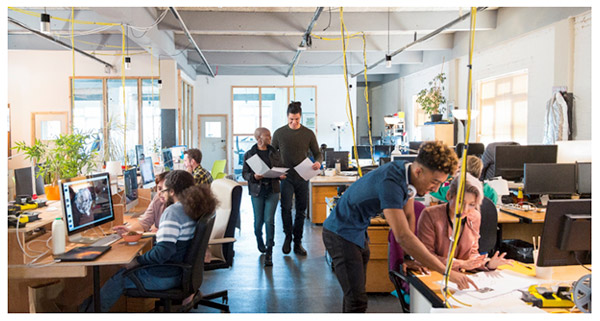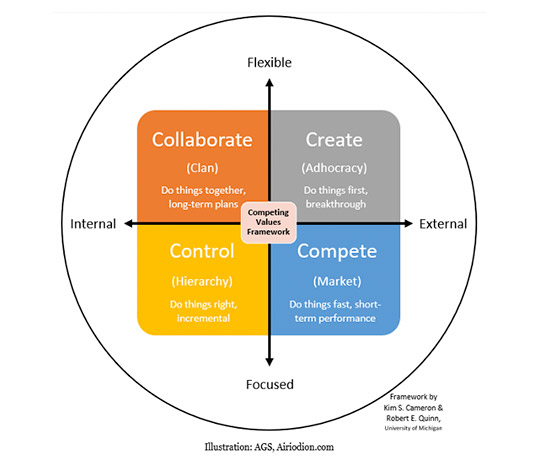What You Really Need to Know about Workplace Culture, Examples, Types, and How to Define Work Culture within Your Firm or Group
Introduction
When a company wins one of those “Best Places to Work” awards it’s because they have a good work culture. And when an organization has a high employee turnover rate and is known as a “toxic workplace” that reflects a bad work culture example.
Company work culture impacts every area of an organization, including some you may not immediately connect with the internal environment, such as customer service and vendor relations. Because employees are the heart of any operation, if they’re happy, companies tend to run well, and if they’re not, they often run poorly.
It’s vital to understand different work cultures and how they impact an organization to build the best workplace culture for a business to thrive.

What is work culture in an organisation? (UK spelling)
In this Best Guide on Workplace Culture, we’ll go through the following helpful topics:
- What is workplace culture?
- Work culture definition
- Three words to describe the work culture
- Work culture meaning to an organization
- Words to describe the culture at work
- The connection between values and culture in the workplace
- Types of workplace culture
- Work culture examples
- Building and changing work culture
- What causes corporate work culture to decline
- How to build the best work culture
See Also: Best Guide on Corporate Culture | All You Need to Know
What is Workplace Culture?
What is work culture? Some may describe it as the atmosphere of a working environment. Others may use work culture words like “toxic,” “collaborative,” or “diverse.”
How to describe work culture takes more than a few words because there is so much that goes into defining a workplace culture. It’s the essence of an organization and embodies things like company and personal values, beliefs, traditions, habits, and priorities.
In an article for Forbes, Dr. Pragya Agarwal used these words to describe a work culture, “A workplace culture is the shared values, belief systems, attitudes and the set of assumptions that people in a workplace share.”
Some companies are great at creating a culture in the workplace and have a very distinct and well-defined corporate culture. For example, Google is known for having a strong work culture, with a laid-back, fun working environment and multiple employee perks not found elsewhere, like free food and a pets-welcome policy.
Other organizations have a far from great work culture and don’t put any thought into the culture at all. For these types of businesses, leaders and departments may end up with different types of work culture, and they may not all be positive.
For example, some of the words describing work culture at certain departments within Wells Fargo Bank might be “corrupt” or “cutthroat.” The institution has been in the news over the last decade due to toxic work environments that fostered practices that resulted in multiple SEC violations.
Workplace Culture Definition
AGS’ workplace culture definition: “Culture in the workplace reflects the personality and working environment of an organization. It is made up of the behaviors, priorities, actions, traditions, and policies created collectively by executives, supervisors, and employees.”
Looking for a shorter answer to “What is work culture?” In the next section, we’ll highlight 3 words to describe work culture.
What Are 3 Words to Describe Workplace Culture?
When you find search results promising three words to describe work culture, often it’s meant to be a multiple-choice survey for employees to fill out. Part of creating work culture descriptions for an organization is surveying staff on how they see their work cultures and environment.
We’ll first touch on the best way to describe the culture in the workplace in just three words, then look at how this is used in employee work culture assessment surveys.
While using 3 words to describe work culture is limiting, it can help you get the point across for those with short attention spans.
3 words to describe work culture:
- Priorities
- Behaviors
- Policies
Priorities can encompass the values and mission of an organization and will drive many work culture examples. If leadership prioritizes doing things right over simply doing things fast, that’s an element that will define the work culture in that company.
The behaviors of executives, managers, and employees will exemplify company work culture even more so than a policy or set of directives. This is because how people behave is ultimately what shapes the working environment. To enact a workplace culture change, it’s necessary to change behaviors to align with the culture.
Policies are the written structure that helps shape good work culture. Policies and directives provide instruction and an answer for “What does work culture mean” throughout an organization.
Employee Survey on Three Words to Describe Work Culture
How employees describe workplace culture is even more important than how a company defines it. This is because there can often be a disconnect between executives in a boardroom trying to describe the culture at work, and the experience of staff on a daily basis.
One of the common questions asked in surveys meant to identify the types of work culture present in an organization is: “Use 3 words to describe work culture at this company.”
The multiple-choice answers will be matched to one of the four main types of workplace culture (which we’ll get into later in this article) to help companies identify culture from the employee perspective.
By limiting the words to describe workplace culture, organizations can streamline the process of work culture identification.
Some of the work culture words typically used as options for this survey question are:
- Controlled
- Flexible
- Collaborative
- Supportive
- Competitive
- Unstructured
- Chaotic
- Nurturing
- Engaging
- Creative
- Outdated
What Does Work Culture Mean to an Organization?
Companies with the best work culture will often make shaping and maintaining their culture a top priority. They understand how important corporate work culture is to the growth and profitability of an organization.
Those that are unsure how to describe the culture in the workplace, often have cultures that have sprung up on their own from the leadership behaviors of managers. This can lead to problems such as several different work cultures existing in an organization, and bad cultures hurting business.
What is work culture in an organisation? (UK spelling) And what does work culture mean to the leadership of a company? It can mean a lot more than some realize.
Creating a culture in the workplace is as important as creating a budget. It provides a vital structure, without which an organization can easily falter and go off the rails.
Here is an example of the importance of workplace cultures and how different types of work cultures can impact a company.
The Best Workplace Culture Can…
- Attract the best employees
- Improve customer experience
- Lower employee turnover
- Improve productivity
- Reduce internal conflict
- Keep everyone on the same page
- Improve profitability
- Ensure business continuity
- Boost brand image
The Worst Workplace Culture Can…
- Decrease employee retention rates
- Stagnate growth
- Cause infighting & conflict
- Hurt customer experience
- Increase mistakes & miscommunication
- Get a company into legal trouble
- Cause unexpected walkouts
- Make it hard to attract new employees
- Hurt brand image
A company’s work culture example can either make or break the business.
Don’t Miss: Implementing a Culture of Change Within an Organization
Values and Culture in the Workplace
A company’s values are reflected in its workplace culture. This can be intentional or not, depending upon whether a company is mindfully building and changing work culture for the better or leaving it to evolve on its own.
How a firm will describe workplace culture in policy statements, isn’t always born out in the culture experienced by employees.
For example, a company may tout its commitment to sustainability and use words to describe a work culture, such as responsible, sustainable, and green. However, if that company dumps toxic waste illegally, then that action will reflect its actual values and culture in the workplace, not what its policies state.
It’s important to align work culture descriptions with corporate values. When words and actions are consistent, it leads to a great work culture that helps companies and their employees succeed and operate effectively together.
What are some of the workplace culture examples of value statements? Here are several that you may run across when reviewing the workplace culture words used on corporate websites:
- Making a difference
- Driving game-changing innovation
- Being a diverse and inclusive workplace
- Shaping a better future
- Honest, integrity, respect
- We do the right thing
- We’re team players
- Commitment to the environment
- We care about what we do
What Are the Main Types of Workplace Culture?
When people ask, “What is a work culture?” the answer can be found in something called the Competing Values Framework. This framework was created by two University of Michigan professors and has been widely adopted as to how to describe work culture in four “personality types.”
Whether a company has an open work culture or one with a strict hierarchy, it can fall into one of four types. Each has its own workplace culture adjectives used to describe the behaviors, policies, and priorities.
Another facet of the Competing Values Framework is that the types of work culture opposite each other from corner to corner on the framework are positioned there for a reason.
For example, you’ll find the words describing work culture under the “Collaborate” type in the upper left-hand side of the illustration. Then in the opposite corner, in the bottom right is “Compete.” These two types of workplace cultures are seen as opposites or competing with each other, hence the name Competing Values Framework.
The same is true if you look at the work culture meaning in the upper right, which is “Create” and compare that to the one in the bottom left, “Control.”
The words to describe workplace culture in the Create category are innovative, few rules, and fast-moving. It would be described as an open work culture. The Control corporate work culture would be seen as opposite and described as structured, process-oriented, with lots of rules. It’s a hierarchal culture.

When looking at each strong work culture in the framework, you’ll also find that two are more externally focused and two are more internally focused. Additionally, two of the work culture examples are more flexible, and the other two are more focused.
According to one of the framework authors, Kim Cameron, “Almost 90 percent of organizations worldwide can be categorized as having one or more of these culture types dominate in their organization.”
Following is the work culture definition for each of these four types.
Clan – Collaborate
This culture in the workplace is very team-oriented and tends to bring everyone in on the decision-making. It’s designed to be nurturing to employees and create a place where everyone can connect and communicate effectively.
- Advantages: Great communication, fewer internal conflicts, engagement, builds loyalty.
- Disadvantages: Slower decision-making because everyone needs to weigh in, can feel off-putting to newcomers, too much discussion and not enough action can impact productivity.
Market – Compete
This workplace culture definition is results-oriented and competitive. The Compete culture can have leaders who are demanding and focused more on the outcome than the happiness and wellbeing of employees.
- Advantages: Gets results, can help people achieve more than they thought they could, is structured, usually has clear guidelines for how success is measured.
- Disadvantages: High-pressure environment, can cause a high turnover rate, can pit employees against each other rather than encouraging teamwork.
Adhocracy – Create
Many startups and technology companies will point to a Create culture when asked, “What is the workplace culture in your company?” Create is about innovation, breaking the rules when necessary, and thinking outside the box. Employees are encouraged to take risks to achieve breakthroughs.
- Advantages: Promotes innovation and continuous improvement, employees feel secure in pursuing new ideas, one of the work cultures that’s flexible and agile.
- Disadvantages: Can lack stability, too much change can cause a chaotic environment, is inherently prone to produce mistakes, which can be costly.
Hierarchy – Control
Control is one of the workplace cultures that you’ll often see in large corporations and institutions. It has a strict hierarchy in place and is very process and rules-driven. There is not a lot of room for freethinking and innovation, and the focus is on proven results.
- Advantages: Stable and efficient, there are clear expectations and paths of communications, security, and predictability, has many checks and balances to mitigate mistakes.
- Disadvantages: Slow to adapt and change, employees can feel like they don’t have a voice, not a strong work culture for innovation and breakthroughs.
Related: Implementing Change Management in the Workplace
Workplace Culture Examples (Positive & Negative)
Next, we’ll go into some workplace culture examples from real-world companies. It’s important to note that good work culture can mean different things to different companies.
For example, some companies will benefit from a collaborative and team-based environment, where others will flourish in a higher-pressure competitive workplace. How employees describe culture at work gives you the most insight into whether a company has a toxic workplace or the best workplace culture.
Other indicators of the need for a workplace culture change for an organization would be if sales were suffering, employee turnover was high, and there were a lot of internal conflict and problems.
Ultimately, in any description of “What is work culture?” you would want employees to be happy and engaged and feel valued. Employee wellbeing directly impacts a company’s operations, customer experience, and bottom line.

The best workplace cultures emphasize employee engagement & wellbeing.
Defining Workplace Culture | Real World Examples of Different Work Cultures
As we go through these different types of work culture examples, you’ll find that it’s not unusual for a company to have elements of more than one of the types of work culture.
Work culture words to describe Google are collaborative, innovative, structured. The company is legendary for going above and beyond with employee perks (like free food, a gym, and more) to keep its team happy and committed.
It’s also got a very clear and structured hierarchy that helps the company define work culture and ensure it is sustained.
Amazon
When you ask employees (and former employees) at Amazon about company work culture, you will find many that describe it as brutal and non-supportive. There are several stories about the Amazon work culture example that discuss things like lack of bathroom breaks, workplace injury being common, and impossible expectations.
However, it’s unlikely that Amazon would consider changing its work culture anytime soon because it seems to be working for it, despite the high staff turnover. The company has only been growing larger, most recently acquiring MGM.
Starbucks
Starbucks is an example of a mix of values and culture in the workplace that combines the best of the Collaborate and Control types of workplace culture.
When asked how to describe work culture, employees posting on Indeed use workplace culture adjectives for Starbucks such as:
- Great place to work
- Fantastic
- Decent pay
- Lots of opportunities
- Fast-paced
- Learned a lot
- Proactive
The Ellen DeGeneres Show
One surprising news story to come out was about the toxic work culture at The Ellen DeGeneres Show on NBC. Words to describe a work culture at the daytime talk show have been discriminatory, unfair, and disrespectful.
Former employees allege that those in the upper ranks were creating a culture in the workplace that punished people for taking time off, was not inclusive, and that made employees feel bullied rather than part of a team.
Ellen DeGeneres announced the end of her show’s long run a little over a year after all those toxic work culture stories surfaced, which had people wondering how much of a role that bad workplace culture played in that decision.
How to Find Words Describing Work Culture
When you’re working to define and build a strong work culture, you want to find the perfect workplace culture words that can help you express your vision to your team.
If you get bogged down with a lengthy explanation of what is work culture in an organisation (UK spelling), you can lose the point and confuse employees. It’s best to find short work culture descriptions that can embody your culture in a few key statements.
Why do you need strong workplace culture words?
Because how you describe the culture in the workplace is going to be used throughout your organization, so you want to be clear and concise. Use action words to describe workplace culture as well as those that embody the passion of your vision and corporate priorities.
Where Can You Get Great Work Culture Description Ideas?
If you’re creating a culture in the workplace either for the first time or as a result of changing work culture to be better, it helps to look at other culture descriptions.
Instead of reinventing the wheel, seeing the words describing work culture by other companies and their employees can give you ideas for shaping your own work culture definition and description.
Here are some of the places you can find words to describe workplace culture:
- Indeed & Glassdoor: Look through the employee review comments and job listings.
- Social Media Profiles: Look at descriptions and “about us” sections.
- Company Websites: Many companies will have employment pages dedicated to answering “What is the work culture at our company?”
Workplace Culture Adjectives
When coming up with the best work culture definition for your organization, it helps to start with some workplace culture adjectives and then branch out from there.
For example, you might start with work culture words like:
- Open
- Innovative
- Dynamic
- Nurturing
Then, from those words describing work culture, expand into a couple of sentences that embody that work culture meaning, such as:
“We are a dynamic company that nurtures employees to achieve their full potential. Our open work culture sparks original thinking and fosters innovation.”
Examples of How Organizations are Defining Workplace Culture:
Zappos:
“It’s about building relationships where we treat each other like family. It’s about achieving the impossible with fewer people. It’s about openness, taking risks, and not being afraid to make mistakes.”
Starbucks:
“We are performance driven, through the lens of humanity.”
Facebook:
“Focus on impact, move fast, be open, build social value.”
Intel:
“Fearless, Inclusion, Customer Obsessed, One Intel, Truth and Transparency, and Quality.”
Popular Article: The Best Practices for Changing Organizational Culture in Healthcare
Tips for Defining Workplace Culture
Every company must have a clear answer to the question, “What is workplace culture at this organization?” Because if you don’t, you could have several workplace culture examples throughout the company that don’t reflect the same values or priorities.
You’ll want to go through a structured process for developing a workplace culture definition, and not just use the first words describing work culture that happen to come to mind.
Here are some tips to help you define work culture and lay a sound foundation to build upon.
Conduct a Work Culture Assessment
It’s important that before you undergo a workplace culture change, you fully understand the cultures that may already exist within different departments. How are leaders and employees currently defining workplace culture?
Conduct a workplace culture assessment that includes surveying your leadership and employees to find out how they describe the culture at work as it currently exists.
When reviewing the results, you’ll want to take note of the policies, behaviors, and environment creating a good work culture and identify core causes of bad workplace culture examples so they can be fixed.
Create Your New Work Culture Meaning & Definition
Based upon the culture assessment, you’ll next craft your workplace culture definition. As we mentioned earlier, it’s easier if you begin with a few keywords describing the work culture that support your mission, values, and priorities.
You’ll then use those words as a base to create a more robust work culture definition.
Align Policies, Guidelines, Hiring Practices, etc.
Your work culture meaning should be reflected throughout the company for a single cohesive message. You may have some policies that conflict with the new work culture examples that you will need to rework.
Review things such as policies, handbooks, guidelines, hiring practices, onboarding materials, and more and update these to support and drive the workplace culture change.
Coach Leaders & Culture Champions
Changing a workplace culture definition is a big undertaking. You’re asking leadership and employees to change the habits and behaviors they’ve formed over time, adopt new policies and procedures, and more.
This is a major change that requires help from leadership and “culture champions” to ensure it’s successful.

Culture Change Champions help new drive work culture adoption from the bottom up.
When you conduct a change from the top down, there is often resentment and change resistance that can cause a new work culture example to fail, and older cultures to come back. It’s important to have the support of leadership and employees that can champion the change to their peers.
These culture change champions and leaders will provide workplace culture examples, modeling behaviors and priorities that back up the new culture and help answer questions about the changes. This bottom-up approach to the change in work culture meaning has a better chance at success.
Click below to learn more about coaching leadership and developing a network of culture change agents.
Best Coaching Practices, Plan & Guide
Complete Guide to Establishing the Best Change Agents Network
What Can Cause an Unwanted Workplace Culture Change?
If you want to develop an environment that could be held up as one of the best workplace culture examples, you have to guard against things that can cause an unwanted or negative work culture.
Changing the definition of, “What is workplace culture?” at your organization requires ongoing vigilance and identification of any toxic cultures that may bubble up in various areas of the organization.
Here are some of the causes of unwelcome workplace culture examples.
Leadership Creating Alternate Workplace Cultures
Strong-willed leaders can end up doing things “their way,” which could be at odds with a company’s work culture definition.
An example of this would be if a company had a collaborative and employee-empowering culture, but a department supervisor decided they wanted a more dictatorial culture, where employees did what they were told without input.
When Work Culture Definition Isn’t Regularly Communicated
When work culture meaning and purpose isn’t regularly communicated or clearly reflected in policies and guidelines, it can become lost.
When a company’s work culture example is weak, then other potentially unwanted cultures can spring up in its place.
Large Scale Layoffs or Key Leader Terminations
If a company goes through large-scale layoffs or terminations of key leaders, it can mean the loss of champions that were responsible in large part for driving work culture meaning and adoption.
Loss of colleagues also leaves a negative feeling with many employees who may wonder, “Am I next?” This can cause employees to completely change how they feel about the workplace culture definition and abandon the behaviors that supported the culture.
Mergers & Acquisitions
Any large disruption to an organization often upends the work culture definition. This is especially the case with mergers and acquisitions where two completely different companies and their words describing work culture are meshing together.
In this case, a mindful workplace culture change that adopts the best of both pre-existing cultures can help drive the adoption of unified new work culture.
What Does a Positive Work Culture Example Look Like?
If you want your company culture to exemplify the best workplace culture examples, it helps to know the hallmarks of great work culture. When a company isn’t experiencing enough of these indicators, it’s a sign that it may need to revisit its work culture meaning.
Focus on Employee Wellbeing
Good work cultures include a focus on employee wellbeing. If employees don’t feel valued and are dreading coming to work each day, then that’s going to reflect in your business operations.
Well-run companies have engaged employees and ones that feel well-taken care of and are not driven to a point of burnout.
High Productivity & Efficiency
As a reflection of the focus on employee wellbeing, an organization with a great company work culture will operate like clockwork, with high productivity and efficiency. Everyone is pulling in the same direction.
Enabled Collaboration & Communication
Miscommunication is a symptom of poor corporate work culture and causes multiple problems. In good work cultures, a company will emphasize clear and transparent communication and focus on team collaboration.
According to the Society for Human Resource Management (SHRM), the cost of poor communications averages $420,000 per year for small companies (100 employees) and $62.4 million per year for large companies (100,000 employees)
Ongoing Personal Development Opportunities
What is a positive workplace culture? It includes developing a team through ongoing career advancement training. When people feel they have a path towards advancement in their company, they’ll contribute towards also helping their company grow and be much less likely to leave for new horizons.
Careful Recruitment Process
Choosing the right team to fit in well with the words describing work culture in your organization helps preserve it. Not every type of work culture, even if it’s a good one, fits every person.
Companies that maintain the best work culture over the long term look for recruits that fit in well with that culture.
Consistent Quality of Services/Products
When you have a positive workplace culture, good communications, and employees are engaged and all pulling in the same direction, mistakes are reduced. This leads to smoother operations and consistent quality for the services/products a company offers.
Excellent Customer Support
A quote by hotelier J.W. Marriott emphasizes how employee wellbeing impacts a company’s customer support. Mr. Marriott said, “Motivate them, train them, care about them, and make winners out of them. We know if we treat our employees right, they’ll treat the customers right. And if the customers are treated right, they’ll come back.”
You can often tell that a company has excellent workplace culture because they’ll be known for exceptional customer support.
Low Employee Turnover Rate
One of the first red flags when it comes to negative work culture examples is a high employee turnover rate. If people aren’t happy at a company and aren’t treated right, they’re going to leave.
Alternately, you can tell a company with positive values and culture in the workplace by a low turnover rate. Happy employees that enjoy where they work will tend to stay there.
Good Business Reputation
Companies with great work culture will usually also have a great business reputation. A positive workplace culture benefits company branding and can attract customers as well as top recruits.
A good work culture definition impacts all areas of an organization for the better and leads to higher efficiency and a company that is a good business partner to work with.
Read More: Adapting to Change in the Workplace | All You Need to Know
Conclusion | Work Culture Meaning & Importance
How you describe the culture at work isn’t just meant to include “feel good” words for recruitment purposes. A company’s workplace culture is at the heart of what that company represents and how it operates.
The beliefs, values, priorities, and behaviors of leaders and employees all make up the collective work culture example a company sets. If a company isn’t defining workplace culture clearly and regularly, it is defined through the different leadership styles of managers organically, which may not make for a great working environment.
By cultivating and maintaining a good work culture, a company can positively impact every area of its organization, from customer support to product quality. So, choose the words describing work culture carefully, and ensure those words are backed up by priorities, policies, and actions.
What is Workplace Culture? FAQ
Good workplace culture is reflected in a strong emphasis on employee engagement and wellbeing. It also facilitates communication and transparency. Hallmarks of great workplace culture include:
The best way to determine the work culture of an organization is through a company culture assessment that includes a survey that employees fill out to answer questions related to how they perceive their working environment.
Building positive culture at work will help improve all facets of a company’s operations. It’s done in a series of steps and should be maintained once workplace culture change has been completed. Steps to build workplace culture include:
Companies with the best work culture will often make shaping and maintaining their culture a top priority. They understand how important corporate work culture is to the growth and profitability of an organization. Workplace culture impacts operations, customer service, product quality consistency, efficiency, employee turnover, and much more. Those that don’t bother to define workplace culture, often have cultures that spring up on their own from the leadership behaviors of managers. This can lead to problems such as several different work cultures existing in an organization, and bad cultures hurting business. Creating a culture in the workplace is as important as creating a budget. It provides a vital structure, without which an organization can easily falter and go off the rails. It’s a critical piece of operational success. Images: Microsoft 365 Clip Art Image(s) (Bing images licensed under the Creative Commons license system.)What is good workplace culture?
• Focus on Employee Wellbeing
• High Productivity & Efficiency
• Enabled Collaboration & Communication
• Ongoing Personal Development Opportunities
• Careful Recruitment Process
• Consistent Quality of Services/Products
• Excellent Customer Support
• Low Employee Turnover Rate
• Good Business Reputation How do you determine workplace culture?
How do you build a culture at work?
• Conduct a Work Culture Assessment
• Create Your New Work Culture Meaning & Definition
• Align Policies, Guidelines, Hiring Practices, etc.
• Coach Leaders & Culture Champions to Help Support the Culture
• Continually Communicate Work Culture to Maintain It Why is culture important at work?
Note: Content on OCM Solution's ocmsolution.com website is protected by copyright. Should you have any questions or comments regarding this OCM Solution page, please reach out to Ogbe Airiodion (Change Management Lead) or the OCM Solution Team today. OCM Solution was previously known as Airiodion Global Services (AGS).






